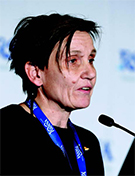Researchers: Use Caution with Benefit/ Risk Ratios in Breast Screening
Researchers are seeking to improve on current models for determining risk/benefit ratios associated with breast cancer screening

Solveig Hofvind, PhD, a researcher in the Department of Screening, Cancer Registry of Norway, spent a year investigating the benefit/detriment ratio estimates of the Norwegian Breast Cancer Screening Program (NBCSP), which launched as a pilot project in four counties in 1995 and expanded nationally in 2004. Under the government- funded program, all women aged 50 to 69 are invited for mammography screening every two years.
Between 2007 and 2015, the Research Council of Norway evaluated the NBCSP to determine whether the program fulfills its intentions and purpose — a target 30 percent mortality reduction. Using one estimate for reduced breast cancer mortality and one estimate for epidemiologic over-diagnosis, the council determined that the screening initiative reduced mortality by 20 percent to 30 percent for women ages 50 to 69, followed to age 79, when compared with no screening.
For women ages 50 to 79, estimates of over-diagnosis for invasive breast cancer and ductal carcinoma in situ (DCIS) combined ranged from 15 percent to 25 percent, compared with no screening.
Although Dr. Hofvind believed that the council’s report had several strengths, she also thought it had several limitations, which spurred her 2015 research project. “There are huge uncertainties in this evaluation, particularly in the over-diagnosis estimates,” she said.
Quality-Adjusted Life-Years May be a Better Approach
In a study presented at RSNA 2015 and later published in the March 2016 issue of the Journal of Medical Screening, Dr. Hofvind and colleagues computed a ratio between the estimated numbers of lives saved from breast cancer death and the number of women diagnosed with breast cancer that never would have been diagnosed during the woman's lifetime had she not attended the NBCSP screening.
Results demonstrated that for every 10,000 women screened biannually, followed until age 79, an estimated 53-61 women were saved from breast cancer death and 45-126 were over-diagnosed. Furthermore, 1,590 women showed falsepositive results with a non-invasive assessment, while 410 showed a false-positive result with an invasive procedure.
The risk/benefit ratio using average estimates was 1:1.4, indicating that the program saved about one life per 1-2 women with epidemiologic over-diagnosis, Dr. Hofvind said.
Dr. Hofvind believes she and her colleagues have improved upon models used to determine estimates of breast cancer mortality and over-diagnosis, adding a new perspective to the issue. Nevertheless, she says the range of the estimates vary substantially and should be carefully interpreted before any information is communicated to women targeted by the screening program.
“Our research demonstrates that it’s very difficult to find clear numbers to show the risk/benefit ratio of mammography screening,” Dr. Hofvind said. “The range is so wide and it depends on so many different factors, that it’s important to understand the screening logistics and the epidemiology in order to choose the right model to estimate such a ratio.”
Comparing Apples and Oranges
In addition, the ratio includes two events — lives saved from cancer death and cases of over-diagnosis — that are not comparable.
“How can you compare saving a woman from dying of breast cancer to a woman who — because of an over-diagnosis — had to undergo local anesthesia and a small excision for a biopsy? Those events aren’t comparable,” Dr. Hofvind said.
In the Journal of Medical Screening study, Dr. Hofvind and her colleagues wrote that using a crude risk/benefit ratio may be misleading and that a better approach may be to use quality-adjusted life-years (QALYs) gained from the prevention of breast cancer compared to QALYs lost due to over-diagnosis.
In any event, if a patient asks for information about risk/benefit ratios, that information should be shared and interpreted with substantial care, Dr. Hofvind said. “I know women may ask about this ratio and we have to be prepared to give them information with the best knowledge we have today,” Dr. Hofvind said.
After the Research Council of Norway evaluation was released, the country’s health minister confirmed that the NBCSP will continue as usual.
Web Extras
- Access Dr. Hofvind’s research in the March 2016 issue of the Journal of Medical Screening at msc.sagepub.com.
- Access the Research Council of Norway’s evaluation of the Norwegian Breast Cancer Screening Program at www.forskningsradet.no.